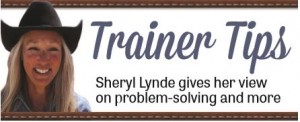 I do get young horses to train from age 15 months and older in order to prepare them for carrying a rider. Depending on the breeding and future goals, these youngsters typically get started around the ages of 2 to 3 years. Physically, you want to ensure the knees are closed prior to having them carry a rider – your vet can determine this for you. Additionally, their bones and muscles are not strong enough to carry weight for extended periods of time until they are the age of 3 or 4, so workouts need to be carefully designed for their age and physicality.
I do get young horses to train from age 15 months and older in order to prepare them for carrying a rider. Depending on the breeding and future goals, these youngsters typically get started around the ages of 2 to 3 years. Physically, you want to ensure the knees are closed prior to having them carry a rider – your vet can determine this for you. Additionally, their bones and muscles are not strong enough to carry weight for extended periods of time until they are the age of 3 or 4, so workouts need to be carefully designed for their age and physicality.
Colts and fillies can be just as dangerous on the ground as an older horse if boundaries have not been clearly established. Although training sessions should be designed for short durations with the young horse, the sessions can be extremely effective due to the willingness of the youngster to follow guidance that is firm as necessary — but as light as possible. I have started many older horses under saddle from ages 5 to 12, and it’s been my experience that the younger horse of 2 to 3 is a much more willing and compliant student. The older horse has developed their own personality and isn’t necessarily convinced they need a leader. Additionally, the older horse has been traveling or carrying himself a certain way for years. Without instruction from a rider, he usually chooses a favorite lead as he lopes out in pasture or turnouts, much like people favor either the right or the left side of their body. For every year after age 2, add an additional two months to your training time for the older horse. The common denominator that will help any horse at any age in the process of being started is how the horse has been handled prior to starting.
When I prepare a horse under age 2 to accept the saddle, I start in the round pen by getting inside and outside turns. The inside turns help in getting her eyes on me — not only in the round pen, but out in pasture when I want to halter her. The outside turns will teach her to respect my space. This is the beginning of teaching her boundaries. The round pen work is done in short increments, always ending with her facing me and standing quietly as I halter her. I will then begin desensitizing her to the lead rope all over her body until she is calm. At this point, I loop the lead rope around her girth area and hold tight for a few moments as I ask her to step forward. I will repeat this several times on each side until she accepts it calmly. This is preparing her for the surcingle which I use prior to saddling. I will end the session at this point for the day.
The following day, I will go through the same exercises as a review and add the saddle pad, laying it on her back and removing it from both sides until she is calm. If all goes well, I will add the surcingle, tightening and loosening at her girth several times before asking her to move forward at a walk with her cinched appropriately. She is on a halter and long lead. When she is able to walk with a soft eye, I will ask for a trot, then the canter. I am in no hurry in this process. We have plenty of time, and my goal is for her to accept each step calmly before I progress to the next step. When she has accepted each stage of the progression, I will add the saddle in the identical method as the surcingle.
I also interject other exercises throughout the sessions that allow me to handle her without added exertion on her part, such as picking up her feet. I begin by holding each foot briefly, then gradually lengthen the time as she gets comfortable balancing on three legs. I also spend time between each exercise backing her up until she is picks up her feet and travels easily without dragging her legs. It is important to vary your exercises and give a quick release and praise when you are given the answer you are asking for. This will keep their interest as well as build on their span of attention, which is limited at this age. After she has accepted the saddle calmly at a walk, trot and canter, then it’s time for ponying
By properly preparing the young horse, the first ride will be a much safer experience for both the horse and rider. Always end on a good note, when she is calm and still willing. Tomorrow is always another day.
Sheryl
Leave a Comment
All fields must be filled in to leave a message.